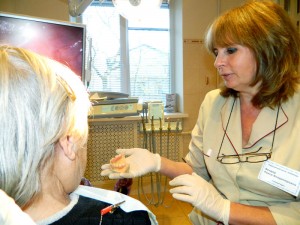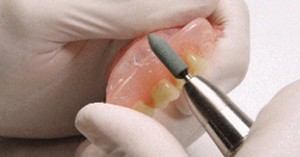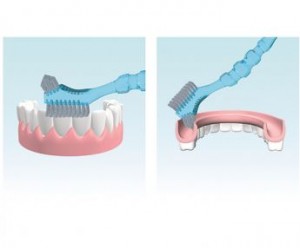What to do if the denture is rubbed

If you do not take measures to eliminate the causes of these unpleasant phenomena, then bloody ulcers may form at the site of contact of the structure with the mucous membrane with the further development of the inflammatory process in the oral cavity.
If a denture is rubbing, what should I do in such a situation?
Most importantly, you should not endure pain, but immediately remove the prosthesis and put it in a glass with a disinfectant.
- Then you must consult a doctor.
- But before going to the dentist, it is necessary that the prosthesis is in the oral cavity for at least four hours.
This is required so that the doctor can clearly identify the area of the mucous membrane that the structure is rubbing, and to make a more accurate correction of the prosthesis in the place that causes rubbing.
Sawing up a prosthesis

It often happens that when dentures are rubbed, patients bring constructs with them.
This is not worth doing, because the doctor should see a clear imprint from the prosthesis and undermine exactly the part that presses on the mucous membrane.
- In removable structures, even one millimeter of the supporting surface plays an important role.
- If you remove the load from one part of the prosthesis, then it will move to the next one.
- This can happen ad infinitum until the prosthesis becomes unusable.
Therefore, only those places of the prosthesis are filed that clearly cause increased friction of the mucosa and are determined by the naked eye.
Any oral comments from patients are not taken into account.
The doctor has the right to file only those parts of the structure that clearly rub the mucous membrane.
A typical prosthesis correction takes from five to ten minutes.
It is enough to make one or two amendments and the use of the prosthesis no longer causes inconvenience to the patient.
Unfortunately, in very rare cases, the prosthesis does not cause complaints in the patient and does not require amendments.
Many patients try to independently file structures, thereby rendering them unusable. Not worth it, in such a situation they are shy, but you just need to see a doctor.
Why the prosthesis can rub
The area of the mucous membrane of the cavity that is in contact with the prosthesis is called the prosthetic bed.
When the patient begins to use the dental structure, the formation of the prosthetic bed begins, the prosthesis, as if looking for its place.
Therefore, discomfort in the oral cavity is felt. The process of getting used to the design lasts up to three months.
This is not an indicator of the quality of the denture. You just have to regularly correct it at the dentist.
Prevention of chafing
Even if wearing the prosthesis is comfortable and does not cause inconvenience to its owner, it must be removed after each meal and cleaned.

- During eating, particles of food that can cause gum rubbing fall under the prosthesis. If the prosthesis rubs the gums, then with a brush it is necessary to thoroughly clean the gingival part of the structure, and then disinfect in an antiseptic solution.
- After each meal, the prosthesis must be removed and always rinsed under running water.
- To rinse the oral cavity with the help of special tools sold in a pharmacy.
- You can rinse your mouth with decoctions of herbs.
- Timely correction of the prosthesis.
- Chewing load distribution on both jaws.
Treatment
- Correction of the dental structure mechanically.
- To speed up the regeneration of the mucous membrane, rosehip or sea buckthorn oil is used. A gauze napkin is impregnated with one of these oils and applied to the affected area of the gums for 15 to 20 minutes. The procedure is performed three times a day. Do not use a prosthesis during treatment.
- The use of fixing gaskets allows you to use the prosthesis with scuffs. Gaskets also protect against inflammation.
- When rubbing the mucous membrane I help healing drugs: calgel, cholisal gel. They have analgesic and anti-inflammatory effects. After applying the gels, dental structures can be used.
- As a folk remedy, honey can be used. It disinfects and heals chafing.